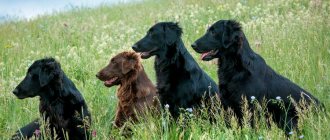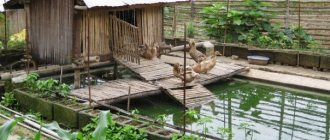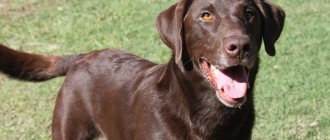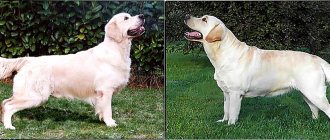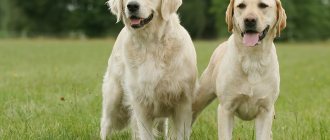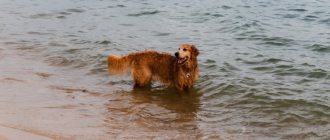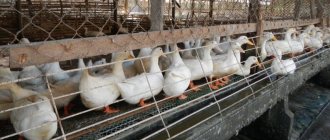The smallest of all retrievers were bred in Canada. Interestingly, in addition to fetching abilities, dogs have a unique ability - to lure ducks. The official name of the breed is Nova Scotia Duck Retriever, or Nova Scotia Retriever for short, or simply Toller. Dogs have proven themselves as companions for active life and sports.
Origin story
As a breed, the Nova Scotia Retriever developed in the early 19th century in the Little River Harbor Community of Yarmouth, Nova Scotia, Canada. It was originally known locally as the Little River Duck Dog or Yarmouth Toller.
The author of works on the history of Canadian dogs dating back to the 18th century, Nicholas Denis, does not deny that small red retrievers could have been brought from the Old World to the Eastern Province of Canada. But it is also likely that the breed developed here in Nova Scotia from several other European breeds. The toller's ancestors could have been Bretons, golden retrievers, spaniels, Irish setters and herding dogs of the border collie type.
In the 17th to 19th centuries, red duck dogs were widespread on the East Coast of Canada. The breed was officially recognized by the Canadian Kennel Club in 1945. The Fédération Cynologique Internationale (FCI) recognized the breed in 1987.
Hunting with a Nova Scotia Retriever calling in ducks
Already by the name, it becomes clear that these dogs can not only bring wounded animals from land or water, but are also capable of luring ducks, which is undoubtedly a unique talent.
The Nova Scotia Retriever works on the same principle as the red fox. He runs along the shore and actively waves his tail. Ducks flock to these movements as if spellbound. On paper this style of hunting seems absurd, but in life it really works.
The hunter hides not far from the shore and throws a stick or ball to the dog. She runs along the pond in search of a toy and creates a fuss. At this time, attracted by the noise and movement of the fluffy red tail, the ducks swim towards the shore as if hypnotized. After a series of successful shots from the hidden hunter, the toller, as befits a true retriever, retrieves the bird from the water. It is worth noting that these dogs adore water, swim very well, can dive, and are ready to work day and night, at any time of the year, until the water is covered with ice. The webbed paws facilitate rapid movement in the water, and the dense undercoat protects against hypothermia.
In most countries of the world, Tollers are used exclusively as retrievers, but among hunters there are true connoisseurs of the breed who, with the help of a dog, lure birds.
Video about the dog breed Nova Scotia Retriever (Toller):
Hunting
Toller is described as an amazing dog with a special gift for attracting and presenting game birds. The four-legged creatures unobtrusively, as if playing, lures the bird into the line of fire. The bird literally stares at the playing Nova Scotia Retriever and loses its characteristic vigilance. The dog fools around until the coveted shot sounds, and then rushes into the water and brings prey to the hunter.
This is interesting! Nova Scotia Retrievers are called duck whisperers, decoy dogs, and fire dogs for their incredible ability to distract birds.
The character of the representatives of the breed can be called persistent or even punchy. The Nova Scotia Retriever is ready to work at any time, day or night, regardless of the weather or state of mind. Even in a doze, the four-legged animal instantly responds to commands or gestures associated with hunting or offering fetch. By the way, the need to offer something is of key importance in training and education. For Toller, treats are not as valuable as praise and the opportunity to bring fetch.
This is interesting! The Nova Scotia Retriever has very developed swimming skills, and in addition, the four-legged animals love water. When passing by a pond, the dog rushes to the shore without permission (since this desire is instinctive), this must be taken into account during walks and training.
Appearance
The Nova Scotia Retriever is an athletic, compact dog with a strong, balanced build, medium bone structure and well-developed muscles. The Toller is the smallest of all retrievers. Height at withers - 43-53 cm, weight - 14-23 kg.
The head is proportional, wedge-shaped. The skull is wide, slightly rounded. The occipital protuberance and cheeks are flat. The distance from the back of the head to the stop is approximately equal to the distance from the stop to the nose. Stop is expressed moderately. The muzzle tapers to the nasal surface, which can be black or brown to match the coat. The lips fit tightly to the jaws. The bite is dense, scissor-shaped. The jaws are strong, but the softness of the grip matters. The eyes are almond-shaped, widely spaced, and medium in size. The color of the iris ranges from amber to brown. The eyelids are the same shade as the nose and lips. The ears are triangular in shape, rounded at the ends, of medium size, set high and bending at the base, falling onto the muzzle.
The neck is set firmly, curved, without dewlap. The back is short and straight. The ribs are well sprung, but not barrel-shaped or flat. The tail is set low, lowered when calm, and during movement or excitement it rises high above the back, but does not touch it. The legs are straight, parallel with well-developed muscles, strong, providing the dog with an elastic, confident gait.
The coat is double, consisting of straight outer hair of medium length and a soft, dense undercoat. On the back, the spine may be slightly wavy. In winter, a collar with a loose curl often forms around the neck. The fringes are soft and moderately long. The fur on the face is thin and short. It is very important that the coat has water-repellent properties so that the dog can safely remove the bird from ice water. Characteristic color: any shade of red. The color should be deeply saturated. White markings are allowed on the tip of the tail, paws, chest and muzzle; their absence is not a fault.
Character and behavior
The Nova Scotia Retriever is a surprisingly multifaceted personality. He is a talented retriever, agile, fast and obedient enough for agility, frisbee and other sports, patient and easy to train for obedience competitions. He is purposeful in his work, energetic, cheerful. Loves to be the center of attention. Ready to do anything to please the owner. The standard says that the toller's eyes light up when he works and this is true. He has one more feature. Nova Scotia Retrievers sometimes “scream” when they are happy or excited. This sound is difficult to convey in words, something between a squeak, howl and growl. The toller has friendly relations with all family members. He gets along well with children of any age, tries to be careful and caring with kids, and shows patience and sensitivity. Of all, the toller usually singles out one; he strives to be a dog of one owner.
Thalers are often confused with golden retrievers, but these breeds are both physically and psychologically different.
The territorial instinct is weakly expressed. The dog will not protect the owner, much less his property, but will bark at passersby and extraneous noises. He treats strangers with caution, he treats the owner’s friends and acquaintances in a friendly manner, but not as friendly with them as a Labrador or a Golden Retriever.
The Nova Scotia Retriever is suitable for a variety of sports. Most often dogs are trained in obedience and agility. Tollers for search tasks are very good, which are an excellent way to develop the innate talents of a retriever.
They get along well with other pets, but being a hunter to the core, they can be too persistent in games, which cats and calmer dogs do not always like.
Education and training
It is important to start working with a toller from an early age; comprehensive socialization is important. It is quite easy to train, and if you add to this the desire to please the owner, then in the right hands he will become an ideal working dog.
A Toller cannot be worked as a service dog. He quickly remembers commands, but does not like to repeat the same thing and lacks perseverance.
Much greater results can be achieved if the classes are as varied as possible. Under no circumstances should you put pressure on the dog, otherwise it becomes withdrawn and will not make contact in the future.
Toller seeks support and praise. This, provided there is close contact with the owner, will be the key to success in education and training.
Mating
Dogs are ready for breeding only after 2 years . Despite early puberty (at 8-10 months), young animals will not be able to conceive and bear healthy offspring. The best time for mating is 13-15 days of the female’s 3rd estrus . During the year, the girl has a period of 2 times; the owner must record the start and end dates of the cycle.
2 weeks before the start, if mating is planned, contact the kennel club to find a partner. This way the puppies will receive official status and documents. Owners need to fill out contract documents and discuss the price.
At the appointed time, the pets are brought together in the dog’s territory or in a neutral place. The animals get to know each other, if the female is ready and the male smells it, he will try to mount. Tollers are proportional, so they do not require assistance. If difficulties in maintaining balance are noticeable, the owners should help the dogs stand up: hold the girl under the stomach, and hold the dog by the lower back.
Repeat mating after 2 days. After a week, the first signs of pregnancy will appear (changes in behavior, lack of appetite). But it is better to carry out tests at 2-3 weeks ; tests (urine, blood) or ultrasound are suitable.
Read a detailed article on the topic: “Everything you need to know about breeding dogs: appropriate age, what to do if it doesn’t work out, rules and tips.”
Content Features
The Nova Scotia Retriever can live in a yard, in an aviary, in a house or in an apartment. It easily adapts to various conditions, if one requirement is met - the dog will not be deprived of attention and will receive the necessary physical and mental stress, will walk and work a lot.
Tollers shed profusely. On walks they like to roll around in the mud or swim in a puddle if there is no body of water nearby. The breed is not the best choice for purists or allergy sufferers.
It is very important to constantly challenge the toller, both physically and mentally. This is the key to happy coexistence between dog and owner. But at the same time, it is a disadvantage for people who are not active enough; they will not be happy with an intelligent and energetic Scottish Retriever.
Care
Toller care includes regular brushing of the coat and bathing as needed. Pet dogs are usually given a full bath with shampoo and conditioner every 1.5 to 2 months. Street 2-3 times a year. It is important to prevent the formation of tangles and regularly examine the ears and skin. The auricle is cleaned as needed. Claws, if they do not have time to grind down, are trimmed to the optimal length approximately once every 3-4 weeks.
Exhibition grooming includes: washing, drying, combing. Light trimming of the fur on the paws, behind the ears, chest, tail and paws is allowed. It gives the appearance a more neat appearance, but should not be excessive. The Nova Scotia Retriever is shown looking as natural as possible.
Nutrition
The Nova Scotia Retriever is generally not a picky eater. Allergy sufferers are rare among dogs of this breed. In addition, they are not prone to overeating. If they lead an active lifestyle, they remain in good shape until old age. The owner can provide a complete diet using natural products or ready-made dry food. A small retriever is suitable for diets suitable for medium-sized dog breeds that lead a normal or active lifestyle. In the cold season, as well as during periods of active physical activity, it is recommended to increase the portion by 1-1.5 times, if necessary.
Nutrition
The health of your pet depends on a proper and balanced diet. The owner of a toller needs to feed the animal with natural products or dry food, which is taught to him at a tender age.
The composition of foods in the diet should include:
- meat;
- sea fish;
- various cereals;
- fruits vegetables.
The Nova Scotia Retriever is not prone to allergies. The amount of food needs to be controlled, since the toller tends to overeat. It is forbidden to give legumes and chicken bones - they cause irreparable harm, especially to young puppies.
Ready-made diets are selected for the category of hyperactive, medium-sized dogs. Mixed meals are not allowed. Fresh water in a bowl is required.
An adult dog needs 1-2 feedings per day. Puppies are fed up to 5 times a day. Babies begin to add porridge to their diet at 2 months of age. Then meat is included in the diet. The volume and variety of natural food is gradually increasing. By the age of 1.5 years, Nova Scotia Retriever puppies eat like adult dogs.
Health and life expectancy
The Nova Scotia Retriever is a strong, healthy dog, strong, resilient, easily adaptable, rarely suffers from allergies or digestive problems, and easily adapts to different climatic conditions and lifestyles. However, there are hereditary diseases in the breed, which are important for current and potential owners to know about.
In Canada, they take the issue of toler health very seriously. A list of diseases recommended for screening in all animals and mandatory for testing in breeding animals has been compiled. This will allow you to create a complete database and wisely select breeding pairs. The list of hereditary diseases of the Nova Scotia Retriever includes:
- Hip dysplasia;
- Progressive retinal atrophy;
- Problems with the thyroid gland;
- Diseases of the heart and blood vessels, including congenital defects;
- Malformations that include malocclusions, cleft palate, cleft lip, cryptorchidism, etc.;
- Degenerative myelopathy;
- Degenerative encephalopathy;
- Intervertebral disc disease;
- Liver shunt;
Life expectancy is usually 12-13 years. Retrievers need standard veterinary preventive measures (vaccination, treatment for external and internal parasites, annual medical examination).
Choosing a Nova Scotia Retriever puppy
In Russia and the CIS countries, the number of Nova Scotia retrievers is growing every year. In total there are already more than 300 dogs. An application has been submitted to create a National Breed Club in Russia, which will allow uniting owners and regulating breeding activities. Several kennels have appeared, dogs continue to be bred by individual owners, so it is becoming increasingly easier to buy a puppy. Another thing is that the toller does not always meet the requirements and have the necessary working qualities. When choosing a puppy, it is important to ensure the responsibility of the breeder and the quality of the parents. A huge plus will be the availability of tests for major diseases that are common in the breed.
It is better to buy a puppy abroad through the National Breed Club. On the websites of such organizations, only advertisements for the sale of purebred puppies that are the result of planned matings are posted. There are plenty of scammers in all countries.
Little Toller puppies are round and soft in every way. Their ears seem disproportionately large to the head, their eyes are expressive, the color of the nose, eyelids, lips and eyes must correspond to the standard. The paws are strong, straight, and because of the soft fluffy fur they appear a little more rounded. The baby should be moderately well-fed, absolutely healthy in appearance, energetic, curious, with an attentive, friendly expression characteristic of the breed.
Price
Abroad, the average price of a Nova Scotia retriever puppy is $800. The cost is influenced by the age of the baby, the working qualities of the parents, their titles, the level of the nursery and much more. In Russia and the CIS countries, breeder owners try to maintain the same price range; on average, puppies are sold for 40,000-45,000 rubles.
Price
In Russia, if it is possible to buy a Nova Scotia retriever, it is with great difficulty. These dogs are an extremely rare breed for our area, and therefore, before you find them, you will have to try hard.
However, dog experts note that there are several nurseries in the country where these animals can be purchased. At the same time, the price of a Nova Scotia retriever will be from 50 to 90 thousand rubles, depending on the class. The show class, considered the elite of the breed, will be valued higher than the breed class.
The lowest level in the hierarchy is the pet class. However, all three categories have a pedigree, are distinguished by high-quality genes, and may have titled parents in their ancestors. The difference between the pet class and the rest is that dogs are not allowed to breed. And representatives of the breed class cannot participate in competitions.
